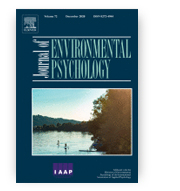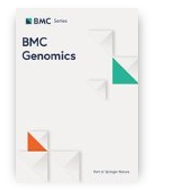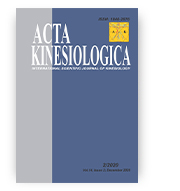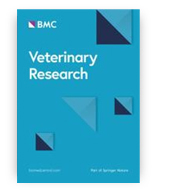Where do we want to see other people while relaxing in a city park? Visual relationships with park users and their impact on preferences, safety and privacy
Aleksandra Lis, Paweł Iwankowski
Journal of Environmental Psychology
 Recreation in a public park is associated with contact with other people spending time in a park setting. The choices people make about visiting a park are not always associated with the need for contact. Sometimes privacy and/or safety is more important, and this is related to the presence of other people in the area and where these people are. We examined how our preferences are influenced by how far other people are from us (distance) and to what extent they are visible (obstruction). We also verified whether the reason for these preferences stems from sense of safety and privacy. To this end, we designed a study in which participants rated 112 photos of park settings in terms of perceived safety, privacy and landscape preference. We measured the distances from people in situ. We measured the degree of obstruction in the pictures as the relative (percentage) quantity of landscape forms constituting a visual barrier. Mediation analyses revealed that (1) increasing the distance from other people in a particular area has a positive effect on preferences, caused by increased privacy and safety; (2) obstruction reduces sense of safety, which in turn reduces privacy and, as a result, reduces preferences. These results indicate that people feel safe and well in situations when they see other people in the area and are not separated from them by visual obstruction, as long as these people are located some distance away. That is why it is worth creating spaces for relaxation located away from active spaces but where the active people are clearly visible.
Recreation in a public park is associated with contact with other people spending time in a park setting. The choices people make about visiting a park are not always associated with the need for contact. Sometimes privacy and/or safety is more important, and this is related to the presence of other people in the area and where these people are. We examined how our preferences are influenced by how far other people are from us (distance) and to what extent they are visible (obstruction). We also verified whether the reason for these preferences stems from sense of safety and privacy. To this end, we designed a study in which participants rated 112 photos of park settings in terms of perceived safety, privacy and landscape preference. We measured the distances from people in situ. We measured the degree of obstruction in the pictures as the relative (percentage) quantity of landscape forms constituting a visual barrier. Mediation analyses revealed that (1) increasing the distance from other people in a particular area has a positive effect on preferences, caused by increased privacy and safety; (2) obstruction reduces sense of safety, which in turn reduces privacy and, as a result, reduces preferences. These results indicate that people feel safe and well in situations when they see other people in the area and are not separated from them by visual obstruction, as long as these people are located some distance away. That is why it is worth creating spaces for relaxation located away from active spaces but where the active people are clearly visible.
10.1016/j.jenvp.2020.101532
New view on the organization and evolution of Palaeognathae mitogenomes poses the question on the ancestral gene rearrangement in Aves
Adam Urantówka, Aleksandra Kroczak, Paweł Mackiewicz
BMC Genomics
 Background: Bird mitogenomes differ from other vertebrates in gene rearrangement. The most common avian gene order, identified first in Gallus gallus, is considered ancestral for all Aves. However, other rearrangements including a duplicated control region and neighboring genes have been reported in many representatives of avian orders. The repeated regions can be easily overlooked due to inappropriate DNA amplification or genome sequencing. This raises a question about the actual prevalence of mitogenomic duplications and the validity of the current view on the avian mitogenome evolution. In this context, Palaeognathae is especially interesting because is sister to all other living birds, i.e. Neognathae. So far, a unique duplicated region has been found in one palaeognath mitogenome, that of Eudromia elegans. Results: Therefore, we applied an appropriate PCR strategy to look for omitted duplications in other palaeognaths. The analyses revealed the duplicated control regions with adjacent genes in Crypturellus, Rhea and Struthio as well as ND6 pseudogene in three moas. The copies are very similar and were subjected to concerted evolution. Mapping the presence and absence of duplication onto the Palaeognathae phylogeny indicates that the duplication was an ancestral state for this avian group. This feature was inherited by early diverged lineages and lost two times in others. Comparison of incongruent phylogenetic trees based on mitochondrial and nuclear sequences showed that two variants of mitogenomes could exist in the evolution of palaeognaths. Data collected for other avian mitogenomes revealed that the last common ancestor of all birds and early diverging lineages of Neoaves could also possess the mitogenomic duplication. Conclusions: The duplicated control regions with adjacent genes are more common in avian mitochondrial genomes than it was previously thought. These two regions could increase effectiveness of replication and transcription as well as the number of replicating mitogenomes per organelle. In consequence, energy production by mitochondria may be also more efficient. However, further physiological and molecular analyses are necessary to assess the potential selective advantages of the mitogenome duplications.
Background: Bird mitogenomes differ from other vertebrates in gene rearrangement. The most common avian gene order, identified first in Gallus gallus, is considered ancestral for all Aves. However, other rearrangements including a duplicated control region and neighboring genes have been reported in many representatives of avian orders. The repeated regions can be easily overlooked due to inappropriate DNA amplification or genome sequencing. This raises a question about the actual prevalence of mitogenomic duplications and the validity of the current view on the avian mitogenome evolution. In this context, Palaeognathae is especially interesting because is sister to all other living birds, i.e. Neognathae. So far, a unique duplicated region has been found in one palaeognath mitogenome, that of Eudromia elegans. Results: Therefore, we applied an appropriate PCR strategy to look for omitted duplications in other palaeognaths. The analyses revealed the duplicated control regions with adjacent genes in Crypturellus, Rhea and Struthio as well as ND6 pseudogene in three moas. The copies are very similar and were subjected to concerted evolution. Mapping the presence and absence of duplication onto the Palaeognathae phylogeny indicates that the duplication was an ancestral state for this avian group. This feature was inherited by early diverged lineages and lost two times in others. Comparison of incongruent phylogenetic trees based on mitochondrial and nuclear sequences showed that two variants of mitogenomes could exist in the evolution of palaeognaths. Data collected for other avian mitogenomes revealed that the last common ancestor of all birds and early diverging lineages of Neoaves could also possess the mitogenomic duplication. Conclusions: The duplicated control regions with adjacent genes are more common in avian mitochondrial genomes than it was previously thought. These two regions could increase effectiveness of replication and transcription as well as the number of replicating mitogenomes per organelle. In consequence, energy production by mitochondria may be also more efficient. However, further physiological and molecular analyses are necessary to assess the potential selective advantages of the mitogenome duplications.
10.1186/s12864-020-07284-5
Lateral and antagonistic asymmetries of lumbo-pelvic-hip complex stabilizing muscles in young Polish women in tensiomyography imaging
Dobrochna Fryc, Karol Bibrowicz, Anna Lipowicz
BMC Veterinary Research
 In terms of pelvic torsion muscle tissue seem to be underestimated. However, it is not clear what is the actual place of muscles in cause and effect chain of posture abnormality pathogenesis. Aim of the study was to characterize morpho-functionally specific group of superficial muscles, that are crucial in human bipedal stability, especially in terms of lateral and antagonistic asymmetries. Material was formed with a group of 34 women aged 22.7±2.8 years (19-29 yr), 166.2±5.6 cm (156-182 cm) of height, 58.4±4.9 kg (48-67 kg). Four of women were excluded because of incomplete data collection. 12 muscles were examined including: right and left Rectus abdominis, External oblique, Erector spinae, Gluteus maximus, Rectus femoris and Biceps femoris. Method selected for the study was tensiomyography with the use of TMGTM science for body evolution apparatus. Results showed lateral asymmetries in External oblique (p=0.01) and Gluteus maximus (p<0.001). Right abdominal muscle appeared to manifest shorter delay time. Gluteus muscle of this side revealed greater maximal displacement as well as longer contraction and summary contraction time. Antagonistic asymmetries in time parameters were found in both tested dyads (Rectus abdominis-Erector spinae and Rectus femoris-Biceps femoris). Rectus abdominis and Biceps femoris shoved higher values revealing more tonic character. In examined group, there are unidirectional functional asymmetries both in lateral and antagonistic muscle dyads. Those differences manifest in TMG procedure, therefore tensiomyography appeared to be a reasonable method for further physiotherapeutic studies and widening knowledge about lumbo-hip-pelvic complex stabilizing muscles.
In terms of pelvic torsion muscle tissue seem to be underestimated. However, it is not clear what is the actual place of muscles in cause and effect chain of posture abnormality pathogenesis. Aim of the study was to characterize morpho-functionally specific group of superficial muscles, that are crucial in human bipedal stability, especially in terms of lateral and antagonistic asymmetries. Material was formed with a group of 34 women aged 22.7±2.8 years (19-29 yr), 166.2±5.6 cm (156-182 cm) of height, 58.4±4.9 kg (48-67 kg). Four of women were excluded because of incomplete data collection. 12 muscles were examined including: right and left Rectus abdominis, External oblique, Erector spinae, Gluteus maximus, Rectus femoris and Biceps femoris. Method selected for the study was tensiomyography with the use of TMGTM science for body evolution apparatus. Results showed lateral asymmetries in External oblique (p=0.01) and Gluteus maximus (p<0.001). Right abdominal muscle appeared to manifest shorter delay time. Gluteus muscle of this side revealed greater maximal displacement as well as longer contraction and summary contraction time. Antagonistic asymmetries in time parameters were found in both tested dyads (Rectus abdominis-Erector spinae and Rectus femoris-Biceps femoris). Rectus abdominis and Biceps femoris shoved higher values revealing more tonic character. In examined group, there are unidirectional functional asymmetries both in lateral and antagonistic muscle dyads. Those differences manifest in TMG procedure, therefore tensiomyography appeared to be a reasonable method for further physiotherapeutic studies and widening knowledge about lumbo-hip-pelvic complex stabilizing muscles.
n/a
Active surveillance for antibodies confirms circulation of lyssaviruses in Palearctic bats
Veronika Seidlova, Jan Zukal, Jiri Brichta, Nikolay Anisimov, Grzegorz Apoznański, Hana Bandouchova, Tomáš Bartonička, Hana Berkova, Alexander D. Botvinkin, Tomas Heger, Heliana Dundarova, Tomasz Kokurewicz, Petr Linhart, Oleg L. Orlov, Vladimir Piacek, Primož Presetnik, Alexandra P. Shumkina, Mikhail P. Tiunov, Treml Frantisek, Jiri Pikula
BMC Veterinary Research
 Background Palearctic bats host a diversity of lyssaviruses, though not the classical rabies virus (RABV). As surveillance for bat rabies over the Palearctic area covering Central and Eastern Europe and Siberian regions of Russia has been irregular, we lack data on geographic and seasonal patterns of the infection. Results To address this, we undertook serological testing, using non-lethally sampled blood, on 1027 bats of 25 species in Bulgaria, the Czech Republic, Poland, Russia and Slovenia between 2014 and 2018. The indirect enzyme-linked immunosorbent assay (ELISA) detected rabies virus anti-glycoprotein antibodies in 33 bats, giving an overall seroprevalence of 3.2%. Bat species exceeding the seroconversion threshold included Myotis blythii, Myotis gracilis, Myotis petax, Myotis myotis, Murina hilgendorfi, Rhinolophus ferrumequinum and Vespertilio murinus. While Myotis species (84.8%) and adult females (48.5%) dominated in seropositive bats, juveniles of both sexes showed no difference in seroprevalence. Higher numbers tested positive when sampled during the active season (10.5%), as compared with the hibernation period (0.9%). Bat rabies seroprevalence was significantly higher in natural habitats (4.0%) compared with synanthropic roosts (1.2%). Importantly, in 2018, we recorded 73.1% seroprevalence in a cave containing a M. blythii maternity colony in the Altai Krai of Russia. Conclusions Identification of such “hotspots” of non-RABV lyssavirus circulation not only provides important information for public health protection, it can also guide research activities aimed at more in-depth bat rabies studies.
Background Palearctic bats host a diversity of lyssaviruses, though not the classical rabies virus (RABV). As surveillance for bat rabies over the Palearctic area covering Central and Eastern Europe and Siberian regions of Russia has been irregular, we lack data on geographic and seasonal patterns of the infection. Results To address this, we undertook serological testing, using non-lethally sampled blood, on 1027 bats of 25 species in Bulgaria, the Czech Republic, Poland, Russia and Slovenia between 2014 and 2018. The indirect enzyme-linked immunosorbent assay (ELISA) detected rabies virus anti-glycoprotein antibodies in 33 bats, giving an overall seroprevalence of 3.2%. Bat species exceeding the seroconversion threshold included Myotis blythii, Myotis gracilis, Myotis petax, Myotis myotis, Murina hilgendorfi, Rhinolophus ferrumequinum and Vespertilio murinus. While Myotis species (84.8%) and adult females (48.5%) dominated in seropositive bats, juveniles of both sexes showed no difference in seroprevalence. Higher numbers tested positive when sampled during the active season (10.5%), as compared with the hibernation period (0.9%). Bat rabies seroprevalence was significantly higher in natural habitats (4.0%) compared with synanthropic roosts (1.2%). Importantly, in 2018, we recorded 73.1% seroprevalence in a cave containing a M. blythii maternity colony in the Altai Krai of Russia. Conclusions Identification of such “hotspots” of non-RABV lyssavirus circulation not only provides important information for public health protection, it can also guide research activities aimed at more in-depth bat rabies studies.
10.1186/s12917-020-02702-y









